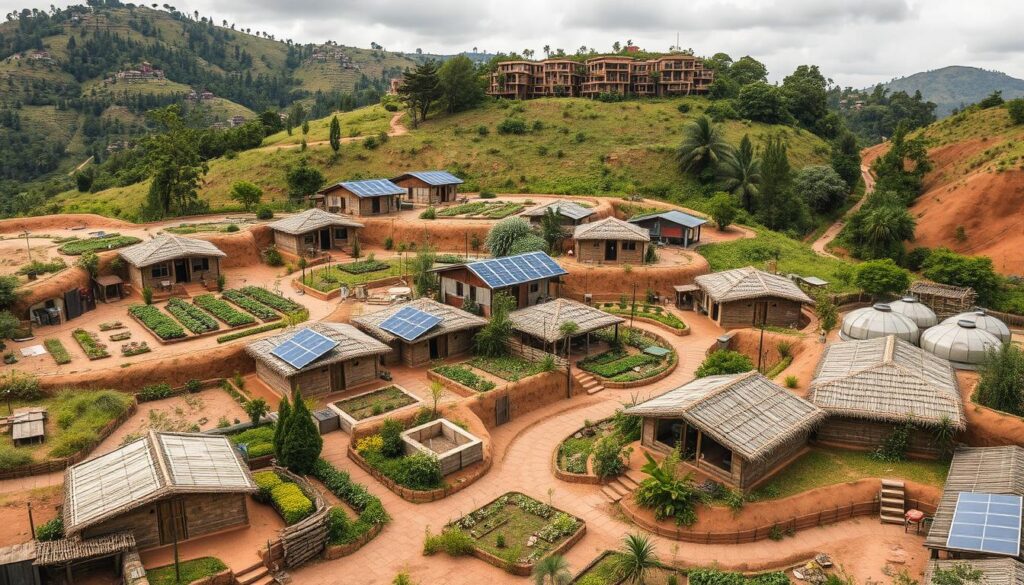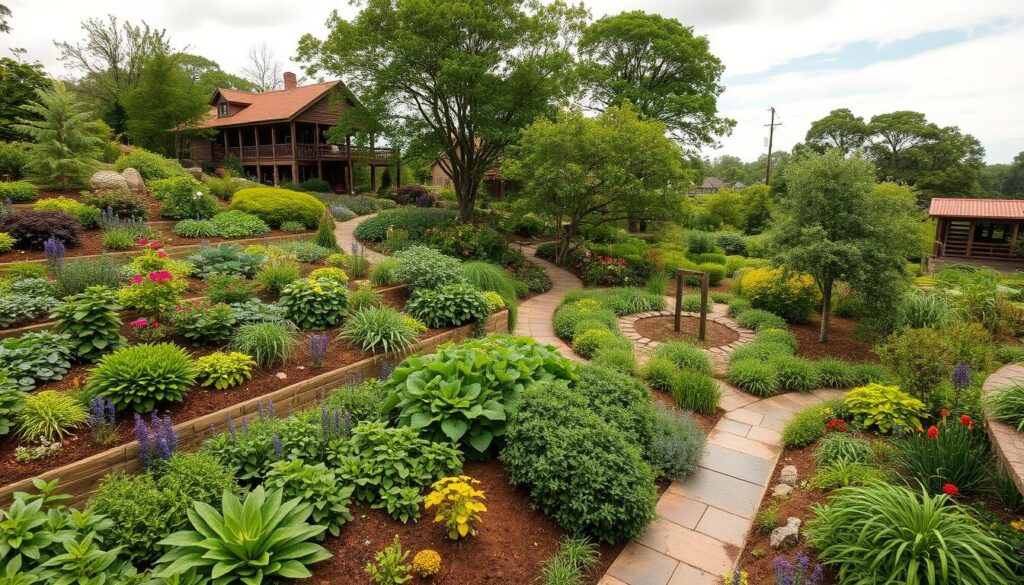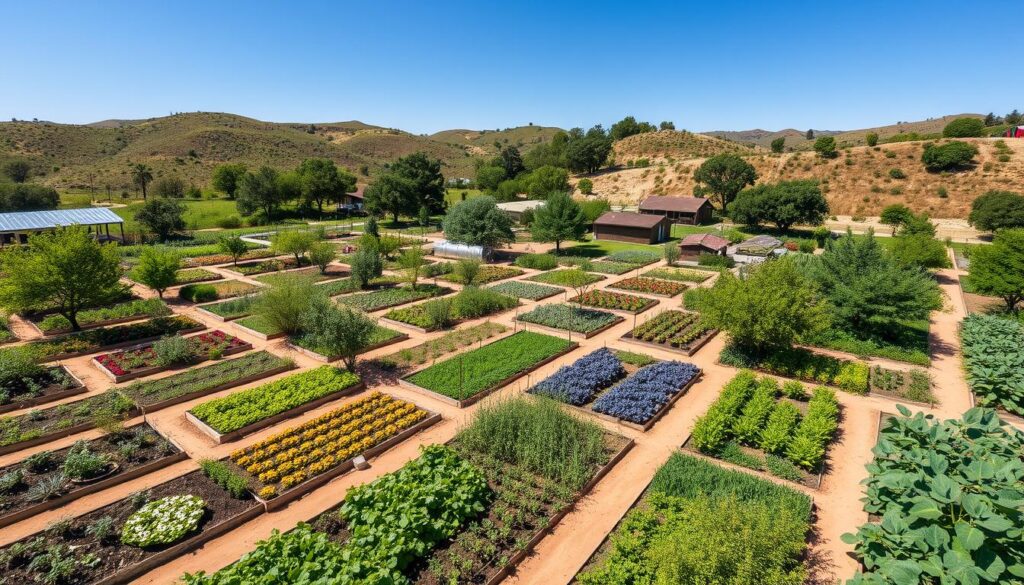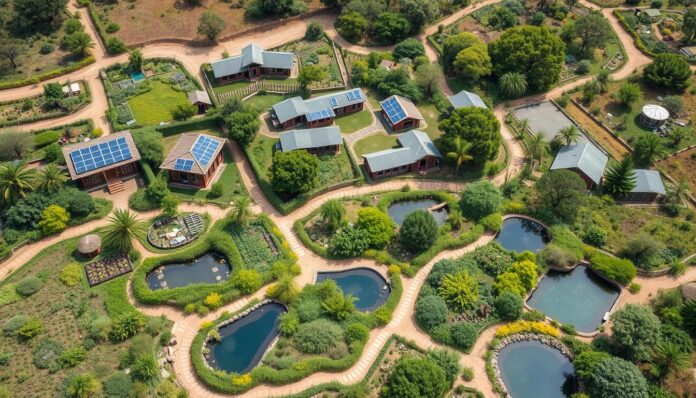Planning infrastructure for permaculture communities is key to creating sustainable places. We use permaculture principles to design systems that support nature, not harm it. This way, we promote ecological health and improve human well-being. Our goal is to use renewable resources more and non-renewable ones less, aiming for a 30% cut in resource use.
Permaculture planning helps build communities that are self-sufficient and kind to the environment. It can cut greenhouse gas emissions by half compared to traditional farming. Also, it boosts biodiversity in farms by up to 50%. Rainwater harvesting systems can slash urban water use by 70%.
Introduction to Permaculture Infrastructure Planning
Permaculture planning is about designing systems that support both nature and people. It focuses on sustainable farming and regenerative land use. This way, we build communities that are self-sufficient and eco-friendly. By working with nature, we can cut resource use by 30% and boost local food security by 25% to 50%.
Key Takeaways
- Permaculture infrastructure planning involves designing systems that work with the natural environment, rather than against it.
- This approach focuses on sustainable agriculture design and regenerative land use, aiming to maximize the use of renewable resources and reduce dependence on non-renewable resources.
- Permaculture infrastructure planning can help reduce greenhouse gas emissions by up to 50% compared to conventional farming methods.
- Implementing rainwater harvesting systems can reduce freshwater consumption by up to 70% in urban permaculture practices.
- Permaculture practices can enhance soil health, resulting in a 30% increase in soil fertility over five years when properly implemented.
- Communities practicing permaculture report an increase of 25% to 50% in local food security indexes due to diversified crop production and reduced dependency on external food sources.
Understanding Permaculture Principles
Permaculture is a way to design that focuses on making systems sustainable and regenerative. It uses eco-friendly strategies to help the environment and improve human life. Green infrastructure planning is key in permaculture, as it aims to work with nature.
At the core of permaculture are three main ethics: care for the earth, care for people, and sharing resources. These ethics guide the design of landscapes that are balanced and diverse. By following these principles, people can build sustainable and thriving communities.
Definition of Permaculture
Permaculture is based on traditional ecological knowledge and nature’s patterns. It helps create environments that are regenerative and self-sustaining. Through green infrastructure planning and holistic design, people can make ecosystems that are sustainable, resilient, and thriving.
Core Ethics and Principles
The core ethics of permaculture are care for the earth, care for people, and sharing resources. These are guided by design principles that aim for balanced and diverse ecosystems. Some key principles include:
- Observe and interact with nature
- Catch and store energy
- Obtain a yield
- Apply self-regulation and accept feedback
- Use and value renewable resources and services
Benefits of Permaculture
Permaculture offers many benefits. It helps create sustainable and thriving communities. Some benefits include:
- Improved ecological health
- Increased food security
- Enhanced human well-being
- Reduced environmental impact
Importance of Infrastructure in Permaculture
Cities are growing fast, with over 55% of people living in them. We need sustainable urban planning more than ever. A good infrastructure is key to a resilient built environment that meets our needs without harming the planet.
It’s vital to invest in climate-conscious infrastructure for a greener future. Green spaces, renewable energy, and smart transport systems help cities use less fossil fuel and cut emissions.
Role of Infrastructure in Sustainability
A resilient built environment can handle climate change’s challenges like extreme weather and rising temperatures. Designing infrastructure with sustainability in mind helps cities thrive. It supports the health of both people and the planet.
Infrastructure as a Foundation for Community
Good infrastructure is also the base for community growth. It offers places for socializing, learning, and business. By using sustainable urban planning, cities can build strong, connected, and green communities.

| City | Population | Carbon Emissions |
|---|---|---|
| New York | 8.4 million | 50 million metric tons |
| Los Angeles | 4 million | 30 million metric tons |
| Chicago | 2.7 million | 20 million metric tons |
Key Elements of Permaculture Infrastructure
Permaculture infrastructure planning is about designing systems that work with nature. It aims to create regenerative land use, eco-friendly development, and sustainable communities. By focusing on water management, soil and land use, and energy solutions, we can build thriving ecosystems.
Effective planning in permaculture needs a deep understanding of the local environment and community needs. We must assess the site’s natural resources, climate, and soil. This helps us plan for water management, soil conservation, and energy generation.
Water Management Systems
Water management is key in permaculture planning. It involves designing systems for rainwater harvesting, greywater recycling, and efficient irrigation. These strategies help us reduce our reliance on municipal water and create resilient ecosystems.
Soil and Land Use Planning
Soil and land use planning are crucial for regenerative systems. We assess the site’s soil, topography, and climate to find the best land uses. Techniques like polyculture planting and agroforestry help create diverse and resilient ecosystems.
Energy Solutions
Energy solutions are vital in permaculture planning. We design systems for renewable energy like solar and wind power. We also use energy-efficient technologies. This reduces our reliance on fossil fuels and makes communities more sustainable and resilient.
| Element | Description |
|---|---|
| Water Management | Rainwater harvesting, greywater recycling, and efficient irrigation |
| Soil and Land Use Planning | Assessing soil conditions, topography, and climate to determine best land uses |
| Energy Solutions | Renewable energy generation, energy-efficient technologies, and reduced fossil fuel reliance |
Site Analysis for Permaculture Projects
Doing a detailed site analysis is key for permaculture projects. It sets the stage for holistic landscape design, green infrastructure planning, and sustainable agriculture design. This step looks at the site’s natural resources, checks the microclimates, and sees what infrastructure is already there.
Evaluating Natural Resources
This part looks at the soil, water, and wildlife on the site. Knowing these things helps create a permaculture system that’s not just sustainable but also helps the environment.
Assessing Microclimates
Microclimates play a big role in permaculture success. By finding areas with special weather and sunlight, designers can make holistic landscape design that does well there. This boosts the whole green infrastructure planning and sustainable agriculture design.
Identifying Existing Infrastructure
Things like roads, buildings, and water systems can be used in the design. This saves money and makes the system work better, fitting with green infrastructure planning and sustainable agriculture design.
By thinking about these points, permaculture projects can meet human needs while protecting the environment. This shows the true spirit of holistic landscape design, green infrastructure planning, and sustainable agriculture design.

| Aspect of Site Analysis | Importance in Permaculture |
|---|---|
| Evaluating Natural Resources | Foundational for sustainable design |
| Assessing Microclimates | Critical for optimizing plant growth and biodiversity |
| Identifying Existing Infrastructure | Essential for cost-effective and efficient design |
Designing Sustainable Water Systems
Creating sustainable water systems is key in permaculture planning. We use practices like rainwater harvesting and greywater recycling. These methods help us use less municipal water and protect the environment.
Some benefits of these systems include:
- Reduced water bills: up to 80% less each year
- Increased water efficiency: 50-90% more efficient
- Improved water retention: 10,000-50,000 liters saved through water-harvesting methods
These systems also help restore local water cycles. This can lead to a 30% increase in native plants in cities. By planning with permaculture, we build more sustainable communities.
Adopting permaculture planning and regenerative practices is crucial for a sustainable future. Using eco-friendly methods like rainwater and greywater recycling is vital. It helps us reduce our environmental footprint and create a better world for all.
| Water Conservation Method | Water Savings |
|---|---|
| Rainwater Harvesting | Up to 80% |
| Greywater Recycling | Up to 70% |
Planning for Soil Health
Soil health is key in permaculture planning. It’s vital for sustainable agriculture design. By using soil assessment and improvement strategies, we can make a holistic landscape design. This design supports ecological health and human well-being.
A good green infrastructure planning system can fight soil erosion. It also boosts soil organic matter and biodiversity. Studies show permaculture can increase crop yields by 30-50% in degraded soils. Agroforestry can cut soil erosion by 40%, making soil healthier.
Some ways to improve soil include:
- Doing a detailed site analysis to find areas for improvement
- Starting crop rotation and intercropping to boost biodiversity
- Using renewable energy to lessen fossil fuel use
For more on permaculture, visit this resource. It shows how crucial soil health is in permaculture planning.

By using these strategies, we can make a green infrastructure planning system. This system supports a sustainable agriculture design. It promotes ecological health and human well-being, and benefits both people and the environment.
| Soil Improvement Strategy | Benefits |
|---|---|
| Crop Rotation and Intercropping | Increase biodiversity, improve soil health, and increase crop yields |
| Renewable Energy Sources | Reduce dependence on fossil fuels, decrease greenhouse gas emissions |
| Agroforestry | Reduce soil erosion, improve soil health, and promote biodiversity |
Incorporating Energy Solutions
Creating a resilient built environment means thinking about energy solutions. We can use renewable energy like solar and wind power. This helps us use less fossil fuels and cut down on greenhouse gas emissions. It’s a big part of making our cities and buildings more sustainable.
Here are some ways to add energy solutions to permaculture:
- Using energy-efficient appliances and systems
- Implementing renewable energy sources, such as solar panels and wind turbines
- Designing buildings and spaces to maximize natural light and heat
These steps help us build a better, more sustainable world. As we keep finding new energy solutions, we get closer to a green future.
Creating Community Spaces
Permaculture planning focuses on making spaces for community interaction. It includes shared gardens for growing food, areas for social events, and places for learning. These spaces help members share skills and learn from each other.
When planning, it’s important to think about what the community needs and wants. Using regenerative land use helps create sustainable ecosystems. Eco-friendly development strategies also play a key role in reducing environmental harm.
- Designing accessible and inclusive areas for all members
- Implementing eco-friendly development strategies to minimize waste and reduce environmental impact
- Encouraging community participation and engagement in decision-making processes
By focusing on community spaces and using permaculture principles, communities can grow strong. They can build a culture of cooperation and support each other well.
The Role of Transportation in Permaculture
Transportation is key in permaculture, shaping a community’s sustainability and strength. By making places walkable and adding green transport, we build a holistic landscape design. This design boosts both nature and human health.
For example, paths for people and animals help manage traffic and improve soil. Studies show that smart grazing cuts soil compaction by half.
A smart green infrastructure planning cuts down on fossil fuel use and emissions. It encourages walking, biking, and using public transport. This boosts community activity by 50%.
Also, good water management in permaculture keeps soil moist by 25%. Techniques like swales and keyline design help a lot.
The perks of green transport in permaculture are many:
* Less carbon in the air
* More exercise for people
* Healthier soil
* Better water in the soil
* More food grown
By using these methods, we build a greener, stronger community. This community supports both nature and people’s well-being.
Permaculture and Waste Management
Effective waste management is key in permaculture. It helps create systems that are regenerative and sustainable. By composting, recycling, and managing organic waste, we support ecological health and human well-being. This aligns with regenerative land use and eco-friendly development goals, aiming to lessen environmental harm.
In permaculture, managing waste includes composting, vermicomposting, and hugelkultur beds. These methods cut down landfill waste and make soil rich for gardening and farming. For instance, composting can make quality compost in 1-3 months with hot composting. Cold composting takes 1-2 years.
Organic mulch also boosts soil fertility over time. It usually needs to be replaced every 1-2 years, based on how fast it decomposes and the materials used.
Effective waste management in permaculture offers many benefits. It reduces greenhouse gas emissions and saves water and energy. It also creates fertile soil for gardening and farming. Plus, it minimizes waste going to landfills.
By using these strategies, people and communities help in eco-friendly development. They support sustainable land use practices.
Integrating Technology in Permaculture Infrastructure
Permaculture communities are growing and changing fast. Technology is key in making these communities strong and green. They use smart water systems and apps to work better together.
These communities also track their resources closely. This helps them use less and waste less. Projects like the Alpha A1 House in Brazil and the Garden House in Ecuador show how well this works.
Technology helps permaculture communities be more sustainable and strong. They use advanced tools and new farming methods. It’s important to keep planning for a green future as these communities grow.
Challenges in Permaculture Infrastructure Planning
Planning for permaculture infrastructure is complex. It involves designing eco-friendly and regenerative land use strategies. But, it faces several hurdles. One big issue is the cost, as starting a permaculture project can be very expensive.
Another problem is dealing with laws that might not support permaculture. It’s also hard to mix modern ideas with traditional practices. Permaculture often uses new methods while valuing old knowledge.
Some of the main challenges in permaculture infrastructure planning include:
- Financial considerations: high upfront costs and potential returns on investment
- Regulatory hurdles: navigating existing laws and regulations to support permaculture practices
- Balancing modernity with tradition: adopting new approaches while respecting traditional knowledge and practices
Despite these challenges, permaculture planning has many benefits. It can improve ecosystem health, increase biodiversity, and better human well-being. By tackling these challenges, we can develop effective strategies for permaculture infrastructure planning.
| Challenge | Description |
|---|---|
| Financial considerations | High upfront costs and potential returns on investment |
| Regulatory hurdles | Navigating existing laws and regulations to support permaculture practices |
| Balancing modernity with tradition | Adopting new approaches while respecting traditional knowledge and practices |
Case Studies of Successful Permaculture Projects
The Chikukwa Permaculture Project in Zimbabwe is a great example of success. It has been running for almost 35 years. It focuses on holistic landscape design and green infrastructure planning to improve both nature and human life.
This project is known for its sustainable agriculture design. It uses polyculture systems and works with the community. Key aspects include:
- Community-led management and decision-making
- Emphasis on indigenous practices and knowledge sharing
- No reliance on external funding, ensuring autonomy and avoiding conflicting rationalities
The Chikukwa Permaculture Project shows how permaculture can help the environment and support local communities. It also helps build social bonds. By studying such projects, we can learn important lessons about success in permaculture.
Looking ahead, it’s crucial to learn from these examples. We can apply their insights to our own projects. This way, we can build more effective and sustainable permaculture systems. These systems should support ecological health, human well-being, and social justice.
| Project | Location | Duration |
|---|---|---|
| Chikukwa Permaculture Project | Zimbabwe | 35 years |
Future Trends in Permaculture Infrastructure
The future ofpermaculture infrastructure planninglooks bright with new ideas and advancements. Communities are moving towardsregenerative land usestrategies. This means more focus oneco-friendly developmentthat cares for the planet and brings people together.
Technology will play a big role in permaculture systems. We’ll see smart irrigation, advanced monitoring, and apps for community work. Also, policies that supportpermaculture infrastructureand green land use will help it grow.
The heart of permaculture’s future is in community involvement. As more people join the permaculture way of life, the need for learning, shared spaces, and workshops will grow. This collective effort will make permaculture a key part of strong, self-sufficient communities.

